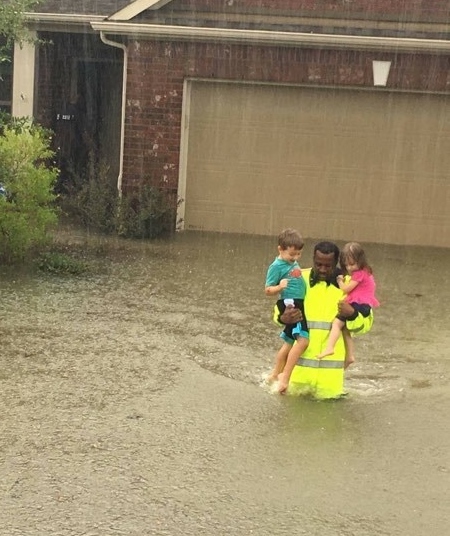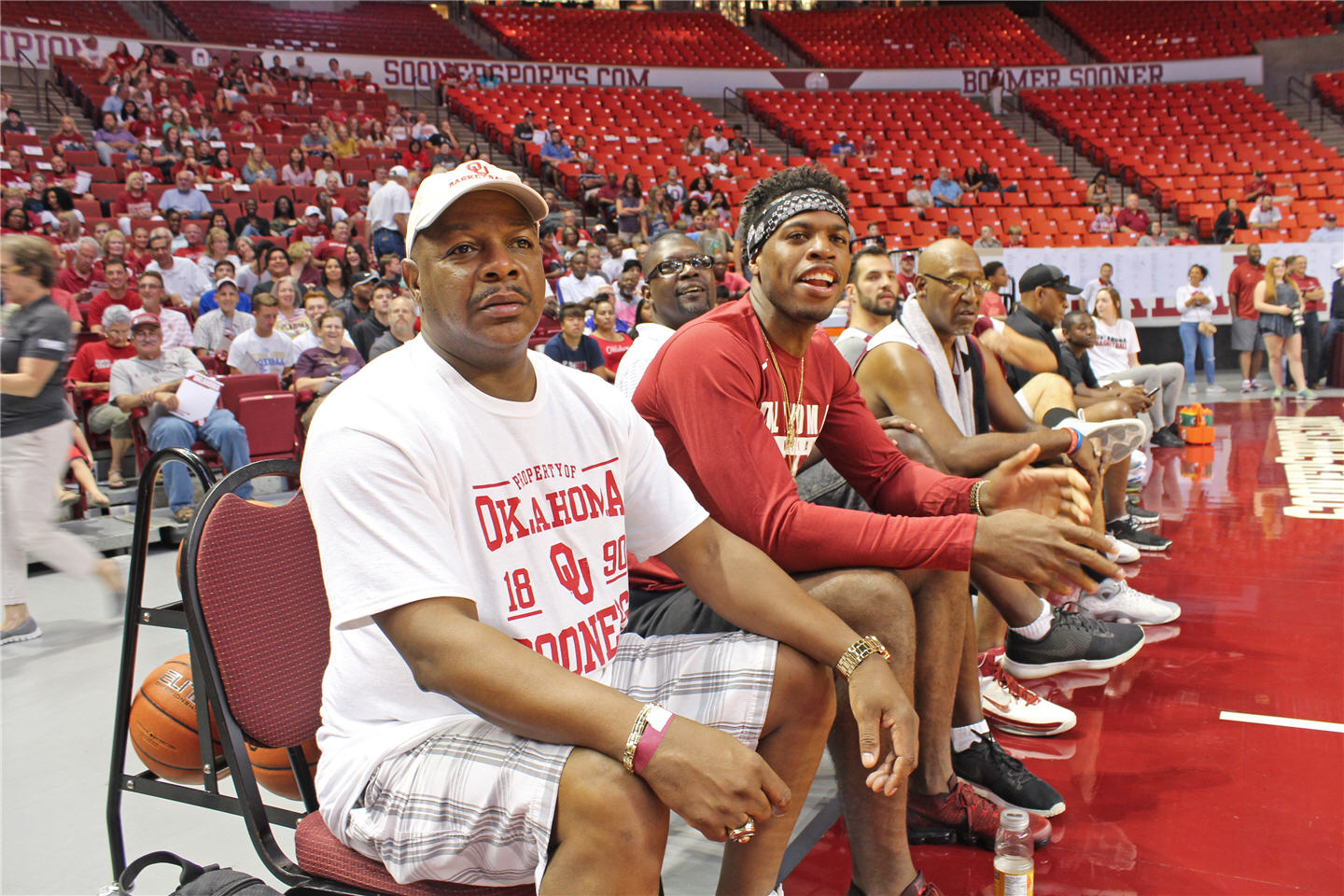
HOUSTON — Rain began to pelt this battered city anew Monday morning, as emergency teams — aided by a growing contingent of citizen-rescuers — plunged into waist-deep water seeking people stranded by devastating, historic flooding in the wake of Hurricane Harvey.
As forecasters warned of more rain, rising rivers and floodwaters that would swallow still more streets and neighborhoods, police described a vast rescue effort, saying they had rescued 2,000 people by Monday morning with more still in need of help. Yet even with several deaths attributed to the storm, the full toll of Harvey’s destruction remained unclear in Houston and across Texas and Louisiana, with officials warning that the flooding would linger and saying more than 30,000 people would be forced from their homes.
“We are not out of the woods yet,” Elaine Duke, the acting Homeland Security secretary, said during a Monday morning briefing in Washington. “Harvey is still a dangerous and historic storm.”
Fears also grew beyond Texas, where the floodwater pounding this city and others was measured in feet, not inches. President Trump on Monday declared “emergency conditions” in Louisiana, where forecasts have called for as much as two feet of rainfall in some areas.
Louisiana Gov. John Bel Edwards (D) had asked President Trump for an emergency disaster declaration, similar to one signed for Texas last week, saying that Harvey posed a “serious danger to life and property” in the state, which is just a year removed from a massive flood disaster. A flash flood watchwas issued Monday morning for part of the state as well as part of Mississippi.
The immediate focus for many remained Houston, the country’s fourth-largest city and a sprawling metropolitan area, which faced dire circumstances and National Weather Service forecasts warning of more heavy rainfall.
Two reservoirs were opened to release water to relieve the stress the downpour has caused in the region, which has seen as much rain in a few days as it averages in an entire year.
“We are seeing catastrophic flooding, and this will likely expand and it will likely persist as it’s slow to recede,” Louis W. Uccellini, the NWS director, said at the Monday morning briefing.
[Cost of cleaning up Harvey will bring new test of governance for Trump and GOP]
Parts of Harris County, which encompasses Houston, were pelted with 30 inches of rain in the past 72 hours, the weather service reported early Monday.
The weather service said Harvey’s rain is causing “catastrophic and life-threatening flooding over large portions of southeastern Texas,” and it warned of more agony to come, estimating that Harvey could produce up to 25 inches along the upper Texas coast and part of Louisiana. Some areas in Texas could see as much as 50 inches of rain, forecasters said.
“We have not seen an event like this,” William “Brock” Long, administrator of the Federal Emergency Management Agency, said Monday morning at a news briefing. “You could not draw this forecast up. You could not dream this forecast up.”
Authorities in Texas fielded scores of calls for help throughout the night from people stranded by water, although many areas had imposed curfew overnight Sunday in hopes of cutting down on the number in need of being rescued from vehicles. Help was pouring in from swift-water rescue teams from around the country.
The Houston police dispatched officers on boats that were sent through streets where the floodwater reached the pumps at gas stations. While urging residents to stay off the roads, police have asked people with high-water vehicles and boats to assist in rescue efforts.
In Houston, the fire department responded to more 4,000 water-related calls for service. Police rescued 2,000 people in the city, and another 185 critical rescue requests were still pending, Art Acevedo, the Houston police chief, said at a news briefing Monday.
“The goal is rescue,” Houston Mayor Sylvester Turner said at the briefing. “That’s the major focus for the day.”
Acevedo also disputed social media claims suggesting that looting had erupted in the city, saying that police had arrested four people for attempting to loot.
Across Houston and suburbs many miles away, families scrambled to get out of fast-flooding homes. Rescuers, in many cases neighbors rescuing one another, used fishing boats, huge dump trucks and front-end loaders to battled driving rains.
[Neighborhood hero leads flood rescue missions]
In downtown Houston, some of the floodwater had receded Monday morning. The swollen Brays Bayou had apparently gone down several feet overnight, while some streets that had been flooded were dry as the sun rose over Houston.
Abandoned cars were left in intersections and alongside roads, and in one case, a school bus had been parked on a high grassy area and left behind. A brief respite overnight had given way to people wandering the streets in the morning, looking at the scattered debris. A woman wearing hospital scrubs, knee-high rubber boots and a backpack, carrying an umbrella, trekked through the water toward a hospital.
But by mid-morning Monday, a hard rain had begun to fall again on the battered city.
The shelter at the M.O. Campbell Center in North Houston had begun turning people away Sunday evening, leaving hundreds stranded, according to local emergency officials.
All day, local fire departments, the Army Reserves and good Samaritans had brought people from their flooded homes to a fire station before transporting them to the M.O. Campbell shelter. But when it reached capacity, the shelter’s doors were shut, and at least 300 people were stranded at the fire station.
[Here’s how you can help South Texas residents affected by Harvey]
The firefighters put a call out for help, asking if anyone could take the evacuees in. One local youth pastor answered the call. The rescue teams picked up Pastor David McDougle, 26, and his wife from their flooded home so they could open the First Baptist Church North Houston as a makeshift shelter for those stranded.
McDougle said he got a call Sunday evening asking if he would let evacuees sleep at the church, so he and his wife took all the food and water they had gotten and brought it to the church.
Though they now have a roof over their heads, the church is not a designated shelter and has no food or water for the evacuees. The church reached capacity with nearly 300 people laying on the floor of the gym, and the food supply ran out around 5 a.m.. People are nervous to drink tap water. The restrooms at the church will not flush, creating a mess of the place.
“It’s frustrating, but I’m just relying on God to fulfill his promises to us,” McDougle said. “We’re all praying.”
[Devastating flooding after Harvey will get worse before it gets better]
The Brazos River, which runs southwest of Houston, is expected to reach record heights in the coming days. National Weather Service models showed the river rising to 59 feet by Tuesday, topping the previous record of 54.7 feet.
Early Monday morning, the Fort Bend Office of Emergency Management issued voluntary and mandatory evacuation orders for wide areas along dozens of miles of Brazos River banks. River banks are expected to overflow across that part of the state as trillions of gallons of rainfall runoff consolidates over coming days.
Authorities expect the Brazos to crest late Tuesday at 59 feet, a record level. “A 59-foot river level threatens to over top many of the levees in out area,” said Fort County Judge Robert Hebert. “It exceeds the design specifications of our levees.”
Herbert said anyone who ignores mandatory evacuation orders — issued for an area that includes a part of Houston with sprawling mansions — will not be aided by first responders when the waters rise.
[Rains from Harvey obliterate records, flood disaster to expand]
Gov. Greg Abbott (R) said Sunday that more than 3,000 national and state guard troops had been deployed to assist with relief efforts. An additional 1,000 National Guard members will be sent to Houston on Monday, Abbott announced late Sunday.
The Federal Emergency Management Agency said federal agencies have more than 5,000 employees working in Texas, and the White House said Trump plans to visit parts of the state on Tuesday.
The devastation that evoked Hurricane Katrina in New Orleans was also reverberating around the world from the Houston area’s large international community. In India, foreign minister Sushma Swaraj posted a tweet Monday saying 200 Indian students were “marooned.”
“They are surrounded by neck deep water,” she wrote.
[Cost of clean up a test for Trump and GOP]
Officials said Houston, a major center for the nation’s energy industry, had suffered billions of dollars in damage and would take years to fully recover. Oil and gas companies have shut down about a quarter of their production in the Gulf of Mexico. Spot prices for gasoline are expected to jump on Monday, but the full extent of damage will not be clear for days, companies and experts said.
Harvey’s sheer size also became apparent Sunday as heavy rains and flooding were reported as far away as Austin and even Dallas. What started with a direct impact on the tiny coastal town of Rockport on Friday night turned into a weather disaster affecting thousands of square miles and millions of people — with no clear end in sight.
The Texas National Guard has deployed across the state, including engineers in Corpus Christi and an infantry search-and-rescue team in Rockport. Another search-and-rescue unit was staging in San Antonio and was likely to be deployed to affected areas shortly, officials said.
[FEMA director calls storm a ‘devastating disaster,’ says it could be the worst in Texas history]
As the extent of the disaster became sharper at daylight Sunday, some criticized Houston officials for not calling for an evacuation of the city.
Turner had defended the decision not to evacuate, noting that it would be a “nightmare” to empty out the population of his city and the county all at once.
Trump has praised the way officials were handling the flood, and he signed a disaster proclamation for Texas on Friday night after Abbott made a dire request warning that the storm would be deadly and lead to billions in damages.
Both of Houston’s major airports were closed, and many tourists and visitors found themselves stranded in hotels with no hope of leaving anytime soon. While Houston was spared Harvey’s initial onslaught, disaster suddenly beset the city, as severe storms Saturday evening gave way to flooding Sunday morning.
The Weather Service said Sunday that at least five people had been reported dead because of Harvey. Local officials have confirmed that at least three people have died as a result of the storm, and officials in the hardest-hit counties expect that as the waters recede the number of fatalities will rise.
As it scrambled to open shelters across Texas, the Red Cross command center in Houston was “physically isolated” because of floodwaters, said Paul Carden, district director of Red Cross activities in South Texas, which includes Corpus Christi.
“The advice is, if you don’t have to be out, don’t be out,” said Bill Begley, a spokesman with the Joint Information Center in Houston. He said most of the calls for help the center had received had come from residents who tried to drive through the storm and got stuck in high water.
In some cases, people could not wait. Early Monday morning, a man came running into the lobby of the Marriott Courtyard hotel in Southwest Houston. He said he had a pregnant woman in his truck who was about to deliver.
Crystal Manker, the hotel’s operations manager, was shocked enough that anyone made it to the hotel, which had been surrounded by deep, impassable floodwaters and abandoned, submerged cars since the night before. Nobody had gotten in or out for 24 hours. But hotel staff went with the man through the swamped parking lot, and finally into waist-deep water where his truck had stalled, with a pregnant woman and her husband inside.
The man said he had seen the husband’s desperate call on Twitter that his wife was in labor and they couldn’t get out of their home. It was close by, so he and a friend drove through the deep water and picked them up. They started toward Texas Children’s Hospital, but as they got closer to the overflowed Brays Bayou, the water became too deep to pass.
As their truck started stalling, saw the Courtyard, which is on the banks of the Bray, and ran inside to get help. Manker said she called 911, and got through after ten minutes. She told the operator the woman’s contractions were eight minutes apart, and the operator told her to call back when they got closer.
At that point Manker said the baby seemed destined to be born in a hurricane-marooned Marriott, so she and her staff rolled a bed into a ground-floor meeting room. They hurried in with sheets, towels, water, pillows and scissors.
Manker remembered that three nurses from Louisiana had been relocated to the hotel. She called them and they rushed down — even though none of them had ever delivered a baby.
As the mother-to-be lay in the bed in the meeting room for more than an hour, Manker called 911 again and told the operator contractions were down to two minutes apart. The nurses were getting ready.
Then a huge city dump truck appeared. Several men helped the woman into the truck, which then headed off into the 4-foot deep water, across the swamped bridge across the bayou and toward the hospital.
Maker was still waiting for word Monday morning on how everything went. She was most amazed at the men who answered the Twitter call for help.
Sullivan reported from Houston and Berman reported from Washington. Emily Wax-Thibodeaux in Katy, Tex.; Robert Samuels, Fred Barbash, Derek Hawkins, Brian Murphy, Thomas Gibbons-Neff, Susan Hogan, Wesley Lowery and Steven Mufson in Washington; Annie Gowen in New Delhi; Justin Glawe in Dallas; Brittney Martin, Stephanie Kuzydym and Dylan Baddour in Houston; Tim Craig in Rockport and Corpus Christi; Ashley Cusick in New Orleans; Mary Lee Grant in Port Aransas, Tex.; and Sofia Sokolove in Austin contributed to this report.
Further reading:
‘All night of slam, bang, boom,’ then a scramble to assess the hurricane’s damage











